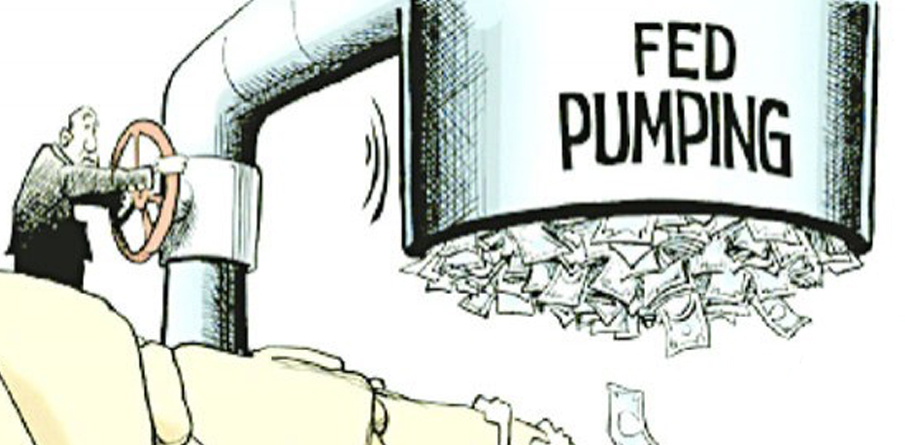Since the last week of October, a great number of central banks have been slashing interest rates, joining the massive synchronization of monetary easing worldwide. This year more than two dozen banks have used easing tactics and in the last two weeks alone central banks from Costa Rica, Hong Kong, Saudi Arabia, United Arab Emirates, Bahrain, Kuwait, Brazil, Indonesia, and Georgia have joined the rate slashing party.
Also Read: Money and Democracy: Why You Never Get to Vote on the Most Important Part of Society
The World’s Central Banks Join Hands to Invoke the Longest Easing Cycle in a Decade
Massive monetary easing continues worldwide but yet central banks are still in panic mode. A colossal amount of synchronization and the longest easing cycle in a decade is upon us as central banks everywhere are attempting to fix the global economy. At the time of writing, 37 developed central banks are participating in some form of stimulus. Whether it’s slashing interest rates, participating in overnight repos, or printing massive amounts of fiat, all the central banks are in on the game. Some of the big players like the U.S. Federal Reserve want the mainstream media to lie and say that what’s happening is not really another form of quantitative easing (QE). However, what central banks are doing right now is expanding monetary easing policies and taking part in large-scale open market operations. The most accurate definition of these processes would be calling the current schemes QE but central banks are not being honest.

When news.Bitcoin.com started reporting on the large number of developed central banks involved in easing tactics there were roughly 19 of them. Then the number was raised a few weeks later to nearly two dozen central banks bolstering different forms of stimulus. Now there are 37 central banks worldwide increasing the global money supply and a slew of them have joined the easing club in the last two weeks. For example, on October 30, the Costa Rican central bank cut key policy rates to 3.35% and cited a lack of economic growth. The same week Saudi Arabia, United Arab Emirates, Bahrain, and Kuwait cut benchmark interest rates as well. The Hong Kong Monetary Authority (HKMA) also reduced its base rate on overnight windows by 25 basis points on October 30. The same day the U.S. Federal Reserve cut rates again for the third time this year.

In what seemed like a rate cut party, Brazil joined the Fed and slashed benchmark interest rates to 5%. Brazil also said inflationary problems might invoke them to continue further easing mechanisms in the near future. Roughly seven days prior, both Chile and Georgia changed interest rates on October 23. Chile reduced rates from 2% to 1.75% while Georgia’s central bank raised refinancing rates to 8.5% from 7.5%. Georgian central planners messed with the rates the month prior twice because of rising annual inflation percentages. Further, even though the People’s Bank of China (PBoC) cut the one-year loan prime rate (LPR) by five basis points on September 20, the economy in China still looks bleak.
China Sees Bank Runs, Skipped Bond Redemption, and Restructuring
For instance, many smaller financial institutions in China are struggling and there have been at least two recent runs on rural lenders. Rumors stemming from social media that a few small banks might fail sparked the bank runs. Then for some unknown reason, Guangdong Nanyue Bank skipped its local tier-two bond redemption. There are more than 3,000 small banks in China that are contending with a lack of liquidity and bad loans. Many spectators believe the Chinese government will resort to “mergers and restructuring.” Inner Mongolia-based Baoshang Bank Co. was already taken over by the communist government because of faulty practices and credit risks.

There’s a lot of interesting happenings within the global economy right now and on top of the central planners trying to band-aid the situation, there are uprisings everywhere. Massive protests have been taking place in Argentina, Venezuela, Indonesia, Netherlands, France, India, Russia, Hong Kong, Chile, Lebanon, Peru, Haiti, Egypt, Syria, and many more countries across the globe. The demonstrations and people taking to the streets stem from the wealth disparity plaguing global citizens. A place where the bureaucrats and the banking cartel eat bread and drink wine while the peasants are left with crumbs.
What do you think about the cascade of central banks unveiling rate cuts and monetary easing methods? Do you think the central banks know what they are doing when it comes to monetary policy? Let us know what you think about this subject in the comments section below.
Image credits: Shutterstock, Fair Use, Pixabay, Wiki Commons.
Do you need a reliable bitcoin mobile wallet to send, receive, and store your coins? Download one for free from us and then head to our Purchase Bitcoin page where you can quickly buy bitcoin with a credit card.
The post QE Infinity: 37 Central Banks Participate in Stimulus and Easing Practices appeared first on Bitcoin News.
Powered by WPeMatico
